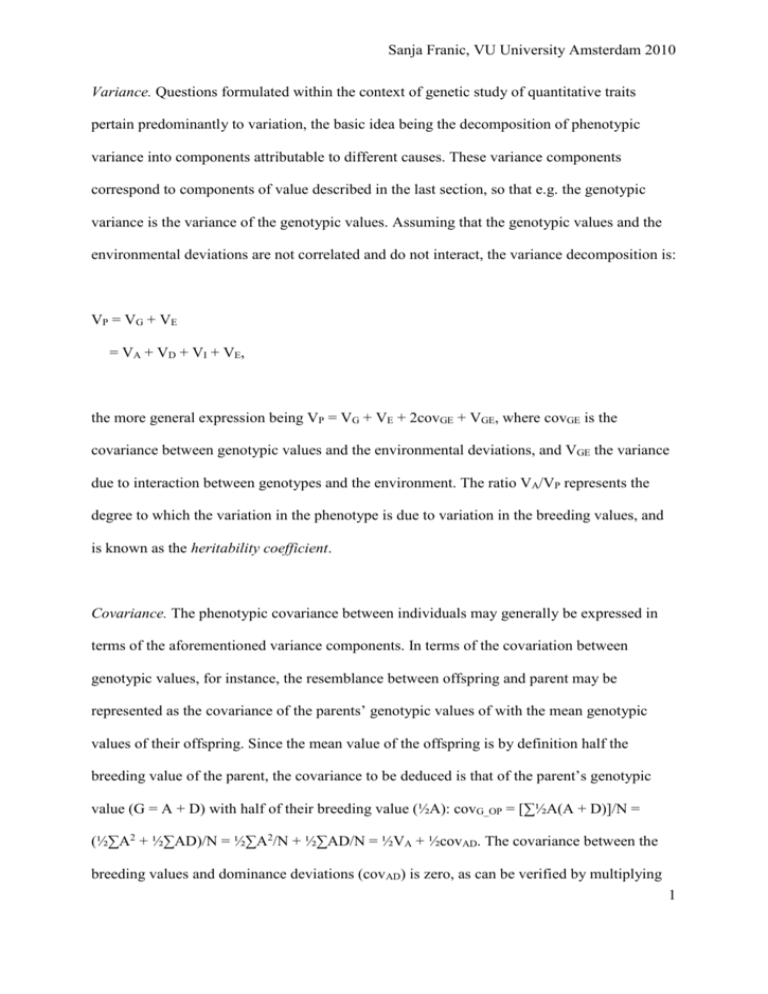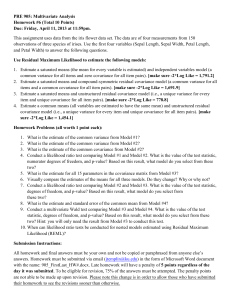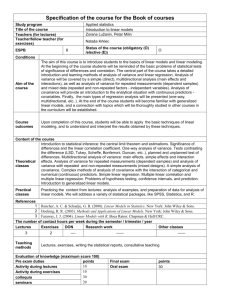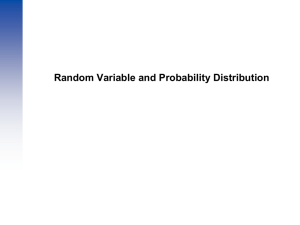Handout 2 – Variance & covariance
advertisement

Sanja Franic, VU University Amsterdam 2010 Variance. Questions formulated within the context of genetic study of quantitative traits pertain predominantly to variation, the basic idea being the decomposition of phenotypic variance into components attributable to different causes. These variance components correspond to components of value described in the last section, so that e.g. the genotypic variance is the variance of the genotypic values. Assuming that the genotypic values and the environmental deviations are not correlated and do not interact, the variance decomposition is: VP = VG + VE = VA + VD + VI + VE, the more general expression being VP = VG + VE + 2covGE + VGE, where covGE is the covariance between genotypic values and the environmental deviations, and VGE the variance due to interaction between genotypes and the environment. The ratio VA/VP represents the degree to which the variation in the phenotype is due to variation in the breeding values, and is known as the heritability coefficient. Covariance. The phenotypic covariance between individuals may generally be expressed in terms of the aforementioned variance components. In terms of the covariation between genotypic values, for instance, the resemblance between offspring and parent may be represented as the covariance of the parents’ genotypic values of with the mean genotypic values of their offspring. Since the mean value of the offspring is by definition half the breeding value of the parent, the covariance to be deduced is that of the parent’s genotypic value (G = A + D) with half of their breeding value (½A): covG_OP = [∑½A(A + D)]/N = (½∑A2 + ½∑AD)/N = ½∑A2/N + ½∑AD/N = ½VA + ½covAD. The covariance between the breeding values and dominance deviations (covAD) is zero, as can be verified by multiplying 1 Sanja Franic, VU University Amsterdam 2010 each of the breeding values by the corresponding dominance deviation and frequency (given in Table 2) and summing over the three genotypes: –4 p2q3αd + 4p2q2(q – p)αd + 4p3q2αd = 4p2q2αd(– q + q – p + p) = 0. Thus the genetic component of the parent-offspring covariance equals covG_OP = ½VA. In full siblings, the mean additive genotypic value of a group of siblings is the mean breeding value of the two parents. Denoting the breeding values of the two parents A and A’, the covariance between the additive genotypic values of offspring is covA_FS = ∑½(A + A’)½( A + A’)/N = ∑¼(A + A’)2/N = ∑¼(A2 + 2AA’ + A’2)/N = ¼VA + ¼VA’ + ½covAA’. The assumption of random mating implies that the covariance between the parents’ breeding values (covAA’) is zero. Thus the covariance of the breeding values of full siblings reduces to covA_FS = ¼VA + ¼VA’. If the additive genetic variance is equal in the two sexes, this expression becomes covA_FS = ¼VA + ¼VA = ½VA. In addition, if parental genotypes at a single locus are A1A2 and A3A4, the offspring may have one of the four possible genotypes: A1A2, A1A4, A2A3, and A2A4. If the first sibling has any of these genotypes, the probability that the second sibling has the same genotype is ¼. Thus, one quarter of full siblings have the same genotype for this locus, and consequently the same dominance deviation. For these pairs, the covariance due to dominance deviations is cov = ∑D2/N = VD. In other pairs the covariance due to dominance deviations is zero. Thus, over all pairs of siblings, the covariance due to dominance deviations is ¼VD. The total genotypic covariance between full siblings is therefore covG_FS = ½VA + ¼VD. The same expression holds true for dizygotic (fraternal, DZ) twins, whose degree of genetic relatedness is the same as that of full siblings. Monozygotic (identical, MZ) twins have identical genotypes and therefore share their entire genotypic variance, thus covG_MZ = VA + VD. 2







